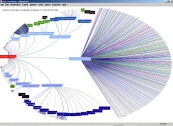|
Large complex and distributed applications, from enterprise
service-centric applications to embedded device applications, have
been developed increasingly with middleware component technologies
like CORBA, RMI/J2EE, and COM/.NET. Each middleware framework offers
a distributed and multithreaded computing platform, and controls
component interactions through component interfaces. These
interfaces encapsulate detailed component implementation, including
the programming language (e.g., C/C++, Java) and the underlying
operating system (e.g., Unix, Windows, VxWorks). The IDL compiler is
often used to automate code generation from component interfaces to
simplify application development.
During the development and evolution of such a large-scale
component-based distributed application, common questions are:
-
What caused the system to crash?
-
Where was time spent?
-
How to package different components onto processors? Does the
second processor really provide significant performance
enhancement?
-
Have all the specified component interactions and paths been
exercised in the integration testing?
-
If a component is changed, what are the units and
subsystems that are required to perform regression testing?
Our research effort here at the Imaging Systems Lab is to develop
new techniques and tools to help answer the above questions, with
the focus on the applications that are running in embedded devices,
and have complex interactions with enterprise services.
Monitoring of Distributed and Component-Based Systems
We have developed a monitoring toolset called coSpy for
distributed and component-based systems. So far, the toolset has
been applied to the applications that are built upon the ORBlite
(CORBA-based runtime developed by HPL), or a particular COM-like
infrastructure (developed by HP). The uniqueness of our approach is
to facilitate system-wide causality propagation in the monitored
application, with no modification to application components. One of
the most important causality information is the caller/callee
relationship due to component-level method (call) invocations. These
coarse-grained invocations are the ones that have their user-defined
IDL interface definitions, and potentially happen across different
threads, processes, and even processors.
The coSpy toolset consists of three parts: the augmented IDL
compiler to automatically deploy instrumentation probes onto the
stubs and skeletons of application components, the
monitoring-related library to collect per-thread runtime execution
information across the entire distributed application, and the
postmortem analysis framework to analyze the collected monitoring
data, determine inter-component interactions, and annotate timing
latency and CPU consumption information onto each component-level
method invocation. In particular, we are able to construct a
system-wide dynamic call graph that structures all component-level
method invocations ever happened in the monitored application run,
following their caller/callee relationships.
An example of our dynamic system call graph from a large-scale
application, configured with 4 processes and 32 threads, is shown
below. Over 100,000 component-level method invocations are contained
in this particular graph. Each invocation is represented by a graph
node. The hyperbolic tree SDK from Inxight
is employed to visualize the call graph.

Testing of Distributed and Component-Based Systems
The cost and complexity of developing and maintaining test suites
to achieve defect-free applications often exceeds that of developing
and maintaining these applications. It becomes much more significant
for large-scale distributed applications that keep evolving within
their life span. Our research effort is to build a test automation
infrastructure and its tool support to reduce the cost and
complexity of developing and maintaining such complex test suites by
automating: test cases generation, test effectiveness evaluation,
regression testing, and impact change determination.
In particular to distributed and component-based applications, we
adopt the two-folded approach: first, to exploit the distributed
systems monitoring techniques that we have developed to perform test
execution runtime monitoring, and to collect and store test
execution information; and secondly, to augment the IDL for test
design specifications and automate the generation of test cases and
the test harness. Overall, our approach is to explore the linkages
among three parties altogether: the application under test, its
behavior model, and the underlying middleware runtime
infrastructure.
Publications:
- Jun Li, “Monitoring and Characterization of Component-Based
Systems with Global Causality Capture,” Proceedings of the
23rd International Conference on Distributed Computing Systems,
pp.422-31, May 2003. Also published as HPL Technical Report
HPL-2003-54. (file in pdf)
- Jun Li, “Monitoring of Component-Based Systems,” HP Labs
Technical Report HPL-2002-25 (R.1). (file
in pdf)
- Jun Li, “Characterization and Impact Estimation of CPU
Consumption in Multi-Threaded Distributed Applications,” HP
Labs Technical Report HPL-2002-50 (R.1). (file
in pdf)
- Jun Li, Keith Moore, “Exploiting Global Causality in Testing
of Distributed and Component-Based Applications,” will appear
as a short paper at the Proceedings of the 20th International
Conference on Software Maintenance, Chicago Illinois, September
2004.
Contact
For more information about the technology, please contact Jun Li
(jun.li@hp.com) at Imaging
Systems Lab, HP Labs.
|
|
|
